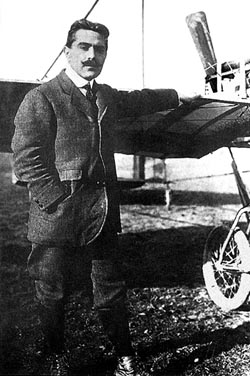
Édouard de Nié Port (Nieuport) (1875-1911)Charles de Nié Port (b. Lagny, France,1878, d. 1913, Etampes, France)
In the summer of 1911, Édouard Nieuport advances that basic design of the Bleriot monoplane and builds the Nieuport 4G, the first airplane with a completely enclosed, streamlined fuselage. On May 12, 1911, Nieuport, a racing cyclist before he went into aircraft construction, sets the recognized absolute speed record of 74.415 mph in a monoplane powered by a 28-hp engine at Chalons, France.
On June 16, he will push the speed record to 80.814 mph. Later that same year he dies in a crash when demonstrating his aircraft to the military
A History of Aeronautics which in part states... The question of reducing the resistance by adopting 'stream-line' forms, along which the air could flow uninterruptedly without the formation of eddies, was not at first properly realised, though credit should be given to Édouard de Nié Port (Nieuport), who in 1909 produced a monoplane with a very large body which almost completely enclosed the pilot and made the machine very fast, for those days, with low horse-power. The subject, was however, early taken up by the British Advisory Committee for Aeronautics, which was established by the Government in 1909, and designers began to realise the importance of streamline struts and fuselages towards the end of this transition period. These efforts were at first not always successful and showed at times a lack of understanding of the problems involved, but there was a very marked improvement during the year 1912. At the Paris Aero Salon held early in that year there was a notable variety of ideas on the subject; whereas by the time of the one held in October designs had considerably settled down, more than one exhibitor showing what were called 'monocoque' fuselages completely circular in shape and having very low resistance, while the same show saw the introduction of rotating cowls over the propeller bosses, or 'spinners,' as they came to be called during the War.
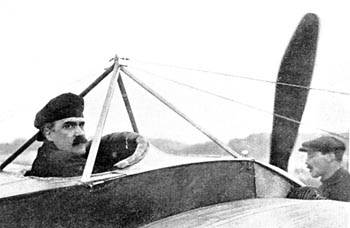 Charles Nieuport and his mechanic Renè Guyot, c.1911/12 photo : Jean-Pierre Lauwers, Bruges/Belgium
Édouard Nieuport Né le 24 mai 1875 à Blida en Algérie d'un père militaire, Édouard de Niéport - qui se fait appeler plus simplement Nieuport - après de bonnes études se prépare à entrer en 1896 à l'école Polytechnique. Mais, il préfère s'adonner à une passion, les courses de vélo et il suit les cours de l'Ecole d'Electricité. Sur deux roues, Édouard Nieuport remporte le prix Zimmermann en 1897 et se classe plusieurs fois des les meilleurs dans les grands prix de vélo en 1898, sur une bicyclette surbaissée à l'avant à cadre Rudge. Les frères Wright, les frères Farman, Roger Sommer, Léon Bathiat, le Belge Jan Olieslagers, Edmond Audemars, Alexandre Anzani, avant d'être aviateur, ont commencé par le sport sur deux roues. read the complete essay at the bottom of this page
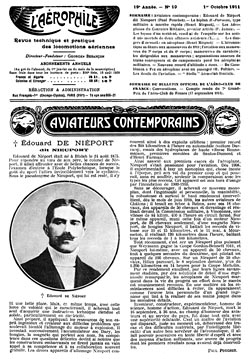 Édouard Nieuport, Obituary l'Aérophile, 1 Oct., 1911 download a 1000pixel image
The Aircraft Nieuport 1, 1909 Longueur 6 mètres; Envergure 7 mètres; Surface portante 12 m 2; Moteur Darracq 18 ch; Poids à vide (sans moteur) 135 kg; Vitesse 70 km/h
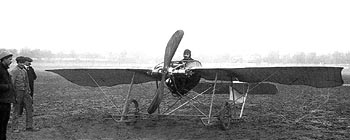 Nieuport 1 download a 1000pixel image
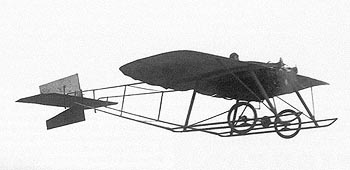 Nieuport 1 download a 1000pixel image
Nieuport 2, 1910 Longueur 7,15 mètres; Envergure 8,65 mètres; Surface portante 15 m 2; Moteur Nieuport 28 ch; Poids à vide (avec moteur) 240 kg; Poids au décollage 350 kg; Vitesse 115 km/h
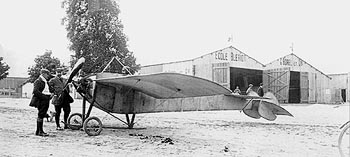 Nieuport 2 download a 1000pixel image
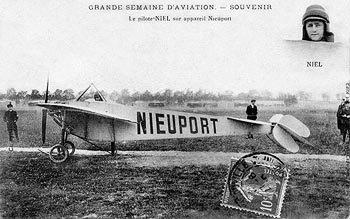 Nieuport 2 download a 1000pixel image
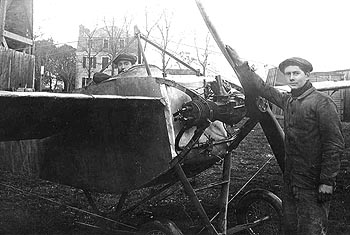 Nieuport 2 download a 1000pixel image
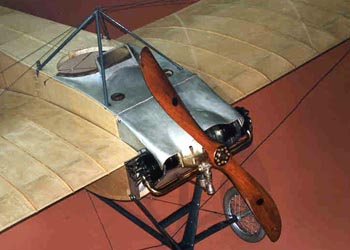 Nieuport 2
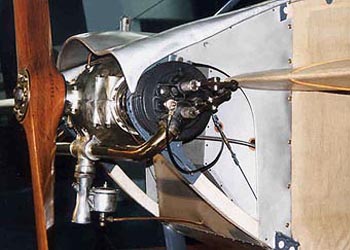 Nieuport 2 download a 750pixel image
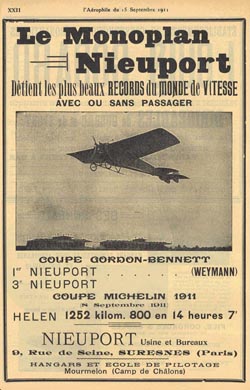 Nieuport 2 l'Aérophile, 15 Sept., 1911 download a 1000pixel image
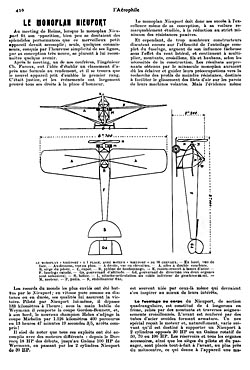 Nieuport 2 l'Aérophile, 15 Sept., 1911 download a 1000pixel image
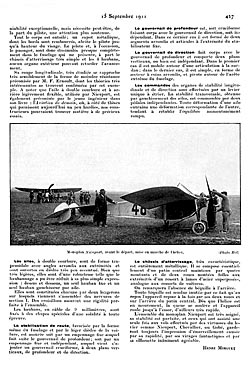 Nieuport 2 l'Aérophile, 15 Sept., 1911 download a 1000pixel image
Nieuport 4G, 1911 Longueur 8,40 mètres; Envergure 10,93 mètres; Surface portante 18,60 m 2; Moteurs Gnôme 50 à 100 ch Poids à vide (avec moteur) 340 kg; Poids au décollage 520 kg; Vitesse 140 km/h
Nieuport 4G Édouard de Nié Port (Nieuport) founded the Nieuport company in 1909 and built only monoplanes until 1914. The type 4G appeared in 1911 and was highly successful; by mid-1912 the French, British, and Italian armies and the R.N.A.S. had each purchased up to a dozen of the two-seaters, including some modified as floatplanes. In October, 1911, Capitano Moizo of the Italian Battaglione Specialisti made possibly the first-ever reconnaissance flight by a military airplane during the war in Libya. Some of the first static and airborne machine gun tests were done with this plane, with the gun mounted in a tubular 'pulpit' to fire over the arc of the propellor. The 4G was also very successful in civil endeavors, setting new speed and distance records almost every time it flew.
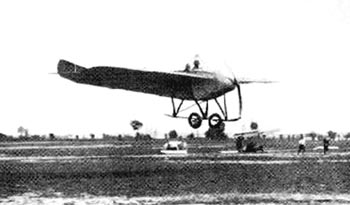 Nieuport 4G download a 750pixel image
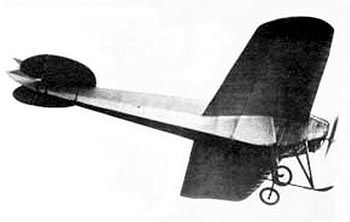 1912 Nieuport IV G of the Swedish Army
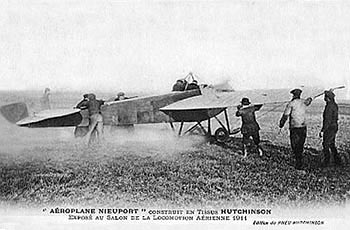 Nieuport 4G
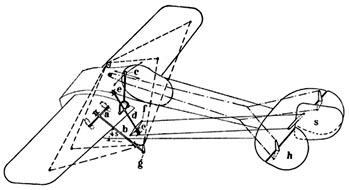 Nieuport 4G, Control System http://members.rogers.com/nieuport download a 750pixel image
The Hydroplanes Nieuport 6G Hydroplane (1911) 6G Hydroplane (1911) : Longueur 8,60 mètres; Envergure 12,25 mètres; Surface portante 24,8 m 2; Moteurs Gnôme 80 à 160 ch; Poids à vide (avec moteur) 545 kg; Poids au décollage 795 kg; Vitesse (100 ch) 150 km/h
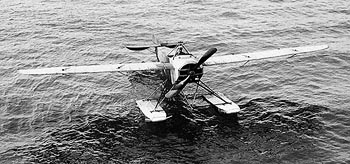 Nieuport 6G, Hydroplane download a 1000pixel image
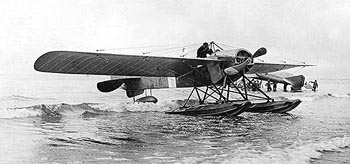 Nieuport 6G, Hydroplane download a 1000pixel image
Nieuport 6H Hydroplane (1912)
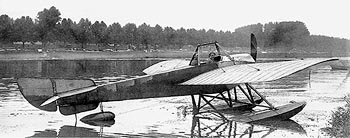 Nieuport 6H, Hydroplane download a 1000pixel image
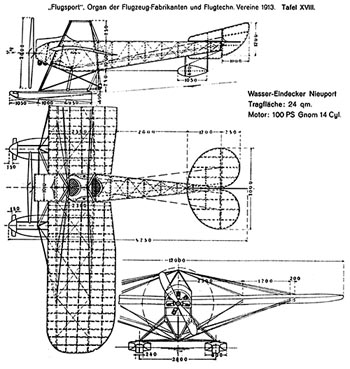 Nieuport 6H, Hydroplane http://members.rogers.com/nieuport download a 750pixel image
Nieuport X Hydroplane, 1913-15 Longueur 8,75 mètres; Envergure 12,35 mètres; Surface portante 24 m 2; Moteurs 80 à 100 ch; Poids à vide (avec moteur) 505 kg; Poids au décollage 795 kg; Vitesse (100 ch) 120 km/h
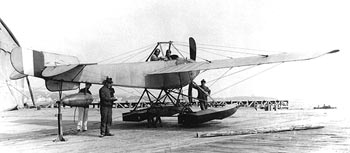 Nieuport X Hydroplane download a 1000pixel image
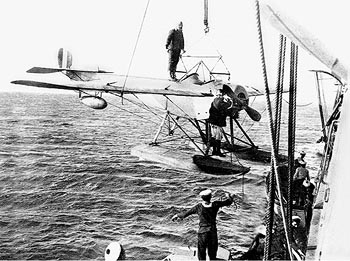 Nieuport X Hydroplane http://members.rogers.com/nieuport download a 750pixel image
Le Nieuport X de la Marine française en poste en décembre 1915 à Port-Saïd en Egypte est le meilleur moyen disponible pour surveiller le canal de Suez. (Cliché Musée de l'Air).
Nieuport 10, 1915
The first design by newly acquired designer Gustave Delage, the Nieuport 10 is a sharp plane, although a bit underpowered as a two seater. Its wing arrangement is most unusual. Both wings are of orthodox wood and fabric construction, but whereas the flat swept-back upper plane has the usual two main spars, the lower had only one. That lower spar is a mere streamlined support for the interplane bracing struts. Unequal chord ailerons, actuated by vertical rods, are fitted to the top wing only; the lower wing has slight dihedral. Distinctive. 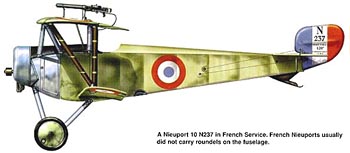 Nieuport 10 http://pilots-n-planes-ww1.com download a 750pixel image
Nieuport 10 : First of the Classic Vee-Strut Nieuports http://www.storks.cwc.net Specialising in the construction of racing monoplanes, Société Anonyme Des Établissements Nieuport enjoyed considerable success in the years and months leading up to August 1914. However, the outbreak of war coincided with a developing official mistrust of the monoplane formula and the company was required to produce Voisan pusher bi-planes under licence. Chief designer Gustave Delage, turning his attention to the developement of an original bi-plane design, evolved a new type of wing celule known as the sesquiplane. The lower wing was much smaller in area than the upper wing and the concept combined the strength of the biplanes wire braced wing cell with the stability and good visibility of the parasol monoplane. In essence the fuselage of the pre-war racing monoplane married to the new concept in wing cell design the Nieuport 10 was the progenitor of the entire "Vee-strut" family. Conceived as a two seat general purpose aircraft the Nieuports debut coincided with the appearance of the Fokker scourge. As a two seater barely a match for the Fokker, experiments proved that it could be an effective fighter if flown as a single seater and properly armed . A single seat variant with a faired over front cockpit was soon devised with a top wing mounted cable operated Lewis gun as the more or less standard armament. ...more
Nieuport 11, 1915 The single-seated fighter Nieuport 11 was one of the well-known French planes of WWI. It was designed by Gustave Delage and built by the French company Société Anonyme Des Établissements. founded in 1909 by Édouard de Nié Port (Nieuport). The plane first entered service on Western front in August 1915. In spite of its small dimensions the fighter had a good technical charachteristics: a high speed, exellent manouverity, high climbing speed. Just for its mobility it was named Bébé (baby) in the same time it confirmed its popularity among the aviators. The names of WWI famous aces like Baracca, Bishop, Ball, Navarre, Nungesser were connected with the fighter Bébé. The Nieuport 11 was a single-seater biplane powered by 60kW rotary engine and equipped with one machine gun above the pilots head on the upper plane. With its manouverity and high climbing speed, it surpassed enemy's aircraft. The Nieuport 11 was also built on licence in Italy and Holland and it named the WWI Allies best fighter.
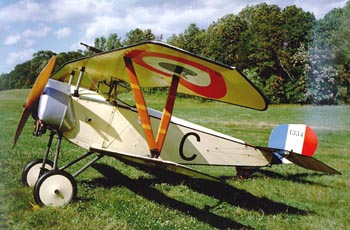 Nieuport 11, 1334 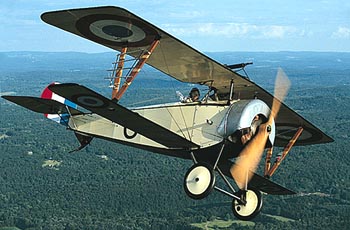 Nieuport 11, 1334 download a 750pixel image
Nieuport 11 : Enter the Bébé http://www.storks.cwc.net The Nieuport 10 was a useful fighter but clearly no more than a stop gap. Something better was needed if the French air service were to find the measure of the Fokker monoplane and it came in the pleasing form of the Nieuport 11 Officialy the Nieuport 11 C1 and unofficialy the baby Nieuport or Bébé, the type 11 again owed its origins to a pre-war racing monoplane. Functional in outline but with an elegance unmistakably French the Nieuport 11 was in many respects the first modern lightweight fighter Despite retaining its predecessors outmoded overwing Lewis gun as armament, in January 1916 it allowed the hard pressed French air service to meet the Fokker monoplane on far better than equal terms. In its admittedly short heyday the baby Nieuport feared no adversary. ...more
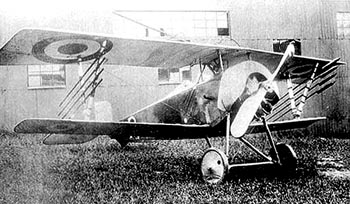 Nieuport 11 fitted with Le Prieur Rockets download a 750pixel image
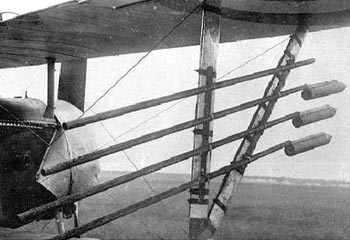 Nieuport 11 fitted with Le Prieur Rockets (detail) http://pilots-n-planes-ww1.com
Read more about Yves Le Prieur and his Rockets
Nieuport Triplane, 1916
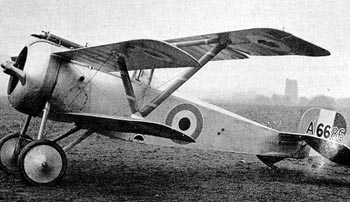 Nieuport Triplane http://pilots-n-planes-ww1.com
Nieuport 12, 1916
A slighter larger Nieuport is now being built under license by the Beardmore Company of Dalmuir, Scotland. A transparent 'skylight' is being provided in the center section, and some machines have small cutouts in the leading edge of the lower wing adjacent to the fuselage. Overall, the new machines have a well-presented streamlined appearance. 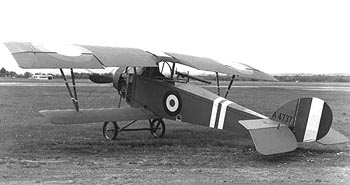 Nieuport 12
Nieuport 17, 1916 The Nieuport was probably one of the more successful fighters of the war and had a longer career than most others. It was built by the Société Anonyme Des Établissements in France. The company was started by Édouard de Nié Port (Nieuport) in 1910. The Nieuport 17 was a combination of the Nieuport 11 and 16. The lower wing was stregenthened as the 11 had a bad habit of losing them in a steep dive. The Nieuport 17 was better at keeping its lower wings, but, some were still lost.
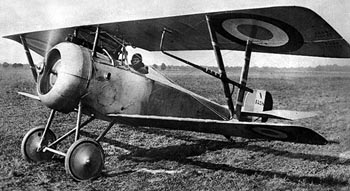 Nieuport 17 download a 750pixel image
The engine was a 110 hp LeRhone rotary engine. The propeller was fixed to the crank and the cylinders would spin around it. Another version of the Nieuport 17 was built. It had a 130 hp Clerget rotary and was known as the Nieuport Nieuport17bis. The plane could reach a speed of 110 and had a wingspan of 26 feet 10 inches. The plane was originally equipped with a Lewis Machine gun mounted on the upper wing that shot above the arc of the propeller. To reload the gun, the Lewis had to be tipped up, the pilot would almost have to stand holding the control stick between his knees, and replace the 47 round drum with a new one.
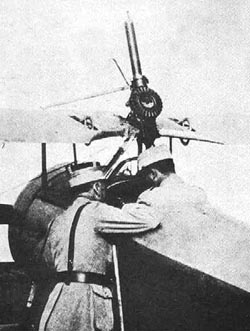 Lewis Gun mounting on a Nieuport 11
After the planes were equipped with a synchronization gear, a Vickers Machine gun was mounted in front of the pilot. This was a belt fed gun and was more deadly because it shot through the prop and was easier to aim at an enemy aircraft. Also, Le Prieur rockets were sometimes mounted on the V struts. These were fired electronically by the pilot and were used mainly against observation balloons. The rockets were very inaccurate but would flame a balloon if the flier got close enough to hit it. The plane showed up on the Western Front early in 1916 and was flown by many aces such as Nungesser, Fonck, Ball and Guynemer. The plane was also flown by Russia, Britain, Belgium, and Italy. By the end of 1917, the Nieuport was quickly becoming obsolete, compared to other aircraft and was replaced by the SPAD VII
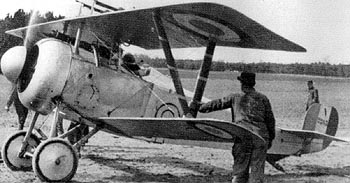 Nieuport 17 Note the Vickers, and twin Lewis guns http://pilots-n-planes-ww1.com
Nieuport 17 http://http://www.storks.cwc.net The deficiency in the Nieuport 11 lay in the armament. Placing the gun on top of the wing, high above the centre line, obviated the need for an interupter mechanism but made aiming and reloading very difficult. With the acceptance in the spring of 1916 of the deadly two gun Albatros DI and DII into German service the need for improvement became even more pressing. Replacing the lightweight Lewis gun with the heavier Vickers, together with its attendant interupter gear and larger quantity of ammunition, required more power than the 80hp Le Rhone could provide. Installing a 110hp Le Rhone into an otherwise virtually unaltered Nieuport 11 airframe produced the Nieuport 16 which was less manoeverable than it's predecessor due to a heavier wing loadingand which in anycase retained the over wing armament. The problem called for a more radical solution. Designed to the same formula as the Bébé, the Nieuport 17 C1 was a completely new aeroplane. Heavier and larger overall than the Nieuport 16, and with a Vickers gun as primary armament, the Nieuport 17 was powered by the same 110hp Le Rhone 9Ja as its predecessor and performance was if anything marginaly inferior. Even so it represented the peak of developement for the vee-strut series and until the Nieuport 28 of 1918 all subsequent Nieuport scouts would in be developed directly from the Nieuport 17 C1. ...more
The Nieuport Aircraft Co., Société Anonyme Des Établissements Nieuport, one of the early pioneering aircraft firms of the early 19th century, was founded by Édouard de Nieuport at Issy-Les-Moulinaux in 1910. This company earned an international reputation for manufacturing good and reputable model planes some of which were as purchased as single seater scouts for the French Military. Édouard de Nié Port (Nieuport) was killed in a crash on September 1911 when he has thirty-six years old, and afterward Gustave Delage, a naval engineer took over as the chief designer and continued with the company though the war years. ...more
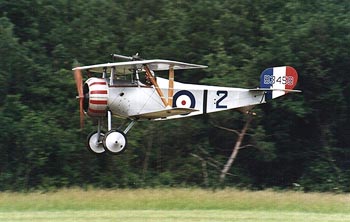 Nieuport 17, B3459
Originally flown by Captain Philip Fletcher Fullard, No.1 Sqn RFC download a 750pixel image
Fullard scored 17 of his victories while flying B3459. Although shown as red, the squadron marking of a vertical bar may have been black. [wwi-models.org]
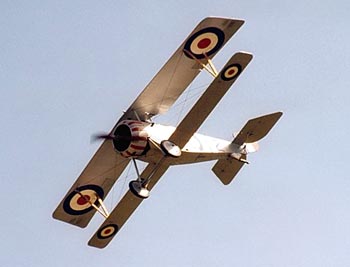 Nieuport 17, B3459
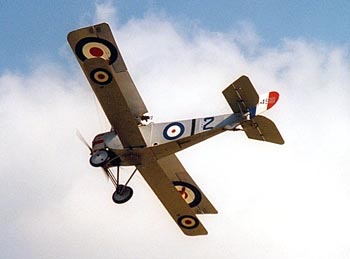 Nieuport 17, B3459
Nieuport 21 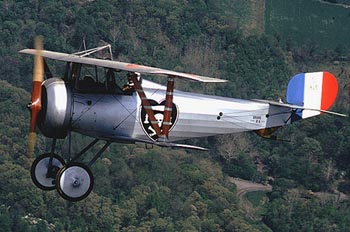 Nieuport 21 download a 750pixel image
Nieuport 28, 1917 The Nieuport 28 was considered pleasant to fly, but its performance was not considered exceptional and it suffered from some design flaws. By 1917 the development of rotary-engined sesquiplane fighters had really had its day and had been eclipsed by the Spad 7 in terms of overall performance and ruggedness. One of the problems was that there was no throttle. Engine speed was partially regulated by switching off the ignition to some of the cylinders. Caution was required as fuel would build-up in the crankcase and often ignited causing a disastrous engine fire. Another problem was caused by the covering which was only glued to the frame; no use being made of rib stitching/tapes. After some use it was possible to rip the covering off the wing when the aircraft was steeply dived. The Nieuport was therefore rejected by the French Air Service. It became the first operational fighter in the American Expeditionary Force simply because there were not enough Spad 13s available. Nearly three hundred Nieuports were purchased. The plane only became a legend because of the list of distinguished airmen in the US Army Air Service who used it.
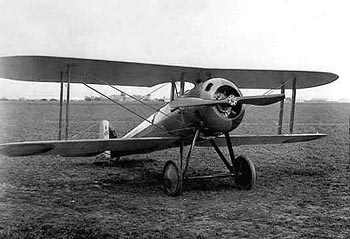 Nieuport 28
Nieuport 28 used with permission from the Copyright © 2000 NASMSI National Air and Space Museum Smithsonian Institution The notable French aircraft manufacturer Société Anonyme Des Établissements Nieuport was formed in 1909 and rose to prominence before World War I with a series of elegant monoplane designs. The namesakes of the company, Édouard de Nié Port (Nieuport) and his brother Charles, were both killed in flying accidents before the war. (The spelling of the company name was a slight variation of the brothers' surname.) The talented designer Gustave Delage joined the firm in 1914 and was responsible for the highly successful war-time line of sesquiplane V-strut single-seat scouts, the most famous of which were the Nieuport 11 and the Nieuport 17 The Nieuport 28C.1 was developed in mid-1917 and was the first biplane fighter design produced by Nieuport that had relatively equal-chord upper and lower wings. In an attempt to compete with the superior performance of the Spad VII and the recently introduced Spad XIII, Nieuport explored the use of a more powerful motor than the types employed in the sesquiplane series. The availability of a more powerful, and heavier, 160-horsepower Gnôme rotary engine prompted the decision to increase the surface area of the lower wing to compensate for the greater weight of the new powerplant, hence eliminating the typical Nieuport sesquiplane V-strut configuration. Because of a number of structural and operational problems, the new Nieuport design was rejected by the French Air Service as a front-line fighter in favor of the sturdier, more advanced Spad XIII, then beginning to fill out French fighter squadrons. Early in 1918, however, the Nieuport 28 found a place with the newly arriving American squadrons. Having no suitable fighter design of its own, the United States adopted the Nieuport 28 as a stop-gap measure before the much-in-demand Spad XIIIs could be made available from the French. Despite its flaws and limitations, the Nieuport 28 performed creditably as the first operational pursuit aircraft in the fledgling U.S. Air Service of the American Expeditionary Force. Thus, the primary significance of the Nieuport 28 for the national aeronautical collection is that it was the first type to carry American colors into combat in organized American units, under American command, in support of American troops, as well as the first type to score an aerial victory with such an American unit. On April 14, 1918, Lieutenants Alan Winslow and Douglas Campbell of the 94th Aero Squadron, both piloting Nieuport 28s, each downed an enemy aircraft in a fight that took place directly over their home airfield at Gengoult. The Nieuport 28 also made its mark in aviation history after the First World War. Of the 297 Nieuport 28 fighters procured by the United States from the French government during World War I, 88 were returned to the United States after the war. Twelve Nieuports, along with examples of several other European types brought back, were employed by the U.S. Navy for shipboard launching trials from 1919 to 1921. Numerous successful, though often harrowing, launches were completed. In poor shape when the Navy received them, these aircraft were either destroyed in accidents during the trials or worn out beyond repair and surplused afterward. The other seventy-six Nieuport 28s that were brought back to the United States after the war were operated by the U.S. Army at various bases and airfields in the 1920s, such as McCook, Carlstrom, March, Mitchel, and Bolling Fields. The Nieuports that survived their post-war U.S. military service found their way into various private hands. Several were modified for air racing, having their wings clipped, adapting non-standard interplane struts, and other changes. A number found their way into Hollywood movies, most notably in the famous Dawn Patrol films of 1930 and 1938. Still others became privately-owned airplanes flying in various sporting and commercial capacities. The specific history of these uses remains quite sketchy. In short, although aesthetically pleasing and by all reports delightful to fly, the Nieuport 28 type gained fame more for simply being available rather than for any inherently superior performance or design qualities. Nevertheless, in American aviation history, the Nieuport 28 holds a number of important firsts and was used in several significant ways. Because of its varied and interesting role in U.S. aviation history, this aircraft has a richly deserved place in the NASM collection. The museum's Nieuport 28 has a complex and confusing history. ...more
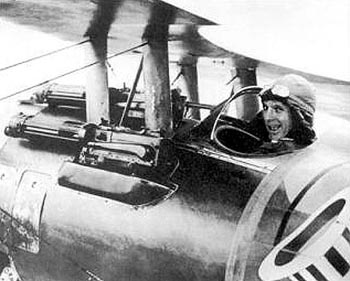 Nieuport 28 Vickers MG detail. Pilot Ted Glennister
Nieuport 29, 1918
M. Delage, designer for the Nieuport 29 C-1 has created an outstanding fighter. I had the opportunity to witness an official trial and it gave an impressive performance, fast and manoeuverable. With a heavy stationary engine and double bays of interplane struts, the 29C-1 is in complete contrast to Nieuportís earlier Scouts.
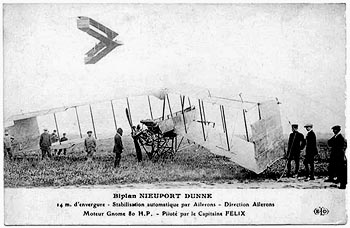 Nieuport Dunne, c.1913-14 download a 1000pixel image
Né le 24 mai 1875 à Blida en Algérie d'un père militaire, Édouard de Niéport - qui se fait appeler plus simplement Nieuport - après de bonnes études se prépare à entrer en 1896 à l'école Polytechnique. Mais, il préfère s'adonner à une passion, les courses de vélo et il suit les cours de l'Ecole d'Electricité. Sur deux roues, Édouard Nieuport remporte le prix Zimmermann en 1897 et se classe plusieurs fois des les meilleurs dans les grands prix de vélo en 1898, sur une bicyclette surbaissée à l'avant à cadre Rudge. Les frères Wright, les frères Farman, Roger Sommer, Léon Bathiat, le Belge Jan Olieslagers, Edmond Audemars, Alexandre Anzani, avant d'être aviateur, ont commencé par le sport sur deux roues.
En 1907, sur ses moteurs d'aviation Antoinette, Léon Levavasseur adopte l'allumage Nieuport-Duplex. En 1907 précisément ont lieu en France les premières envolées d'aéroplanes à moteur à essence : le 15 mars, Charles Voisin réussit à Bagatelle (le terrain de sport du bois de Boulogne-sur-Seine) sur un biplan Voisin à moteur Antoinette un superbe vol piloté de 80 mètres, sous les yeux de Archdeacon et des commissaires sportifs de l'Aéro-Club de France ; toujours à Bagatelle, Léon Delagrange sur biplan Voisin à moteur Antoinette effectue un vol de dix mètres le lendemain, suivi d'un vol de deux cents mètres le 30 mars ; Blériot vole dix mètres le 5 avril à Bagatelle sur son monoplan Blériot VIII, puis plus de cent mètres à Issy-les-Moulineaux (Hauts-de-Seine) le 25 juillet ; Henry Farman sur le même terrain, vole sur 285 mètres le 15 octobre et 770 mètres le 26 octobre sur un biplan Voisin à moteur Antoinette de 40 ch ; Robert Esnault Pelterie, à Buc (Yvelines) le 19 octobre, monte à six mètres en hauteur, sur un monoplan de sa conception dont il a réalisé le moteur. Le 13 janvier 1908, le jour où Henry Farman remporte le prix Archdeacon pour son vol d'un kilomètre à Issy-les-Moulineaux, Édouard et Charles Nieuport, soutenus financièrement par le lieutenant de Caumont, transforment la société d'équipements électriques en société d'aviation, sous le nom de Société Générale d'Aéro-Locomotion, (SGA). Pour apprendre à piloter, Édouard Nieuport achète en 1909 un biplan Voisin. Nieuport I (1909)
Longueur 6 mètres Nieuport ne fait pas partie des premiers avionneurs, ceux qui défrichent le terrain, mais de la seconde génération, celle des sportifs recherchant les performances. A 35 ans, avec son passé de sportif, il veut créer des machines racées. La SGAL réalise un premier monoplan ultra léger (195 kg moteur inclus) à la fin de l'année 1909, baptisé « l'araignée » lequel sera détruit par les inondations de la Seine de janvier 1910 après avoir volé à Issy-les-Moulineaux. Le Nieuport I, avec un moteur de 18 ch seulement, est très rapide puisqu'il vole à 70 km/h. En avril 1910 à Mourmelon-le-Grand (Marne) où un camp militaire de parade et de manoeuvres existe depuis 1857, Nieuport s'installe par commodité, suivant l'exemple d'Henry Farman. Un incendie causé par un nouvel allumage Nieuport-Duplex y détruit le biplan Voisin. Sur le monoplan Nieuport II Édouard Nieuport obtient son brevet de pilote de l'Aéro-Club de France le 10 juin 1910 (n°ree; 105). Le pilote se fait remarquer par ses évolutions serrées, en particulier des descentes sur l'aile qu'il est le premier à effectuer. Le Nieuport II est un petit monoplan monoplace dont le fuselage est constitué de quatre longerons de frêne reliés par des entretoises de sapin raidis par des cordes à piano ; le fuselage est entoilé jusqu'à la queue. Les ailes sont étroites et à corde profonde, avec une légère flèche. Sous la responsabilité de Henri Depasse, le directeur commerciale de la firme, le monoplan Nieuport commence à se vendre. Le type II N comportant un meilleur stabilisateur à l'arrière, plus stable et plus confortable est exposé au Salon de l'aéronautique de décembre 1910. Le Nieuport type III est proposé après le salon de 1910. C'est un type II N biplace, solution exigée par l'Armée. Malheureusement, le 30 décembre, de Caumont se tue sur le prototype du Nieuport III dont le plan de queue se rompt en vol. La firme perd son commanditaire. Nieuport II N (1910)
Longueur 7,15 mètres A Reims (Marne) en 1910, Édouard Nieuport est chronométré sur le Nieuport II N avec le moteur Darracq 18 ch à 84,400 km/h. Avec l'ingénieur Echard, les frères Nieuport modifient le bicylindre Darracq, par augmentation des cotes (130 mm d'alésage, 135 mm de course) dont ils tirent de 28 (à chaud) à 32 ch (à froid) à 1 300 tours, le moteur entraînant une hélice Régy de 2,02 mètres. Le 9 mars 1911 à Mourmelon, Édouard Nieuport est chronométré sur le II N propulsé par ce moteur et une hélice Nieuport à 109,9 km/h. Le 21 mai, avec l'hélice Régy, il atteint 119,680 km/h, battant le record du monde de vitesse que détenait Alfred Leblanc sur Blériot à moteur Gnôme de 50 ch, 109 km/h. Vendu 18.000 francs, le Nieuport II N à moteur Nieuport de 28 ch connaît un certain succès commercial, avec une soixantaine d'exemplaires achetés. L'adoption du moteur rotatif Gnôme donne le type Nieuport II G, un appareil biplace doté d'un capotage avant dont le plan de queue est redessiné (dérive en un seul plan). Avec un sept cylindres de 50 ch, le Nieuport II G qui est vendu 25.000 francs, vole déjà à 125 km/h. Avec un sept cylindres de 70 ou 80 ch, le II G, vendu 28.000 francs, vole à 135 km/h. Avec un quatorze cylindres de 100 ch, le Nieuport II G commercialisé 36.000 francs vole à plus de 145 km/h. Le 12 juin 1911, Alfred Leblanc sur le Blériot XI à moteur Gnôme de 100 ch reprend le record du monde de vitesse à Nieuport, avec 125 km/h. Mais quatre jours plus tard, Édouard Nieuport se remet en piste sur le II G avec un simple Gnôme de 50 ch et dépasse 133 km/h. En début d'année 1911 sort le Nieuport type IV, un monoplan identique au type II mais de dimensions plus imposantes, avec une envergure portée à 10,93 mètres. Il peut accueillir un, deux ou trois passagers. Peu après, Nieuport qui peut s'appuyer sur Léon Bazaine pour diriger ses ateliers, sur son frère Charles pour effectuer les réceptions des avions militaires II G et IV G, recrute l'ingénieur naval Gustave Delage pour réaliser des versions hydro de ces derniers. Il recrute le pilote Américain Charles Weymann, qui vit en France. En 1911, les monoplans Nieuport se taillent une réputation de machines rapides, avec des victoires spectaculaires. Weymann sur le Nieuport II G à moteur de 100 ch remporte le 1 er juillet 1911 à Eastchurch en Angleterre la Coupe de vitesse Gordon-Bennett, devant Alfred Leblanc et Édouard Nieuport. Armand Gobé, sur un Nieuport II G à moteur de 70 ch, remporte le concours de distance de l'année 1911, avec un vol de 740 kilomètres. C'est sur un Nieuport IV militaire à moteur Gnôme 70 ch que le pilote Russe Piotr Nicolaïevitch Nesterov effectuera la première boucle, le 27 août 1913. Nieuport IV G (1911)
Longueur 8,40 mètres Malheureusement, en présentant son type IV militaire au concours militaire à Reims en septembre 1911, alors qu'il a piloté dans un vent contraire depuis Issy-les-Moulineaux, Édouard Nieuport se heurte à la tablette à carte fixée devant lui à l'atterrissage, déclenchant une hémorragie interne qui cause sa mort.
Le général Roques, qui avait demandé ce vol à Nieuport, demande aux constructeurs les performances suivantes :
Weyman remporte le concours militaire en novembre 1911, devant sept autres constructeurs, presque tous ayant réussi les épreuves. Voici le classement du premier concours d'aviation militaire de l'histoire. Il est historique.
1. Weyman, monoplan Nieuport IV G, 100 ch. 117 km/h ; Cependant, l'Armée, convaincue par la valeur du monoplan Nieuport II N, commande à la firme de Suresnes douze appareils à moteur Le Rhône 80 ch pour former une escadrille, la N 12, qui sera formée à Reims en début d'année 1913. La firme Nieuport vacille un instant, mais Charles reprend le flambeau, avec Delage comme ingénieur.
|
© Copyright 1999-2003 CTIE - All Rights Reserved - Caution |
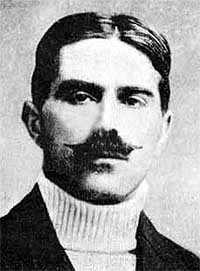 Édouard de Nié Port (Nieuport)
Édouard de Nié Port (Nieuport)